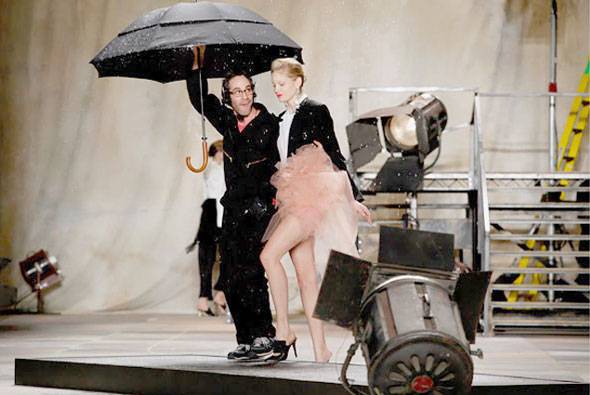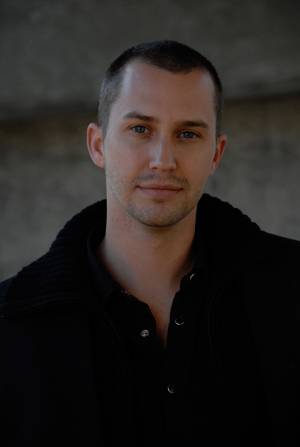Martha: How do you come up with the idea for the fashion installations for presentations or runway shows? Does the designer tell you to run with it, or are you given precise directions?
Michael Brown: The creative kickoff for all my work is vastly different from project to project, fueling my own imagination and sparking new ideas all the time whether it’s a first or the fifth season I’m working with a designer. Runway and installation designs emerge from the confluence of several sources in a process… a client’s creative direction and collection inspirations, the particular venue and staging needs for the event, and a compilation of visual source imagery that I compose to fuel the collaborative dialogue. Some clients offer key words or imagery that inspired the collection, or perhaps descriptions of the color, tone and textures of the clothing; others may provide richly detailed theatrical anecdotes that anchor the character of the season. The key for me is that I’m designing the premiere live experience of a new fashion collection.
M: What inspired you take on such a (beautifully) creative career in design?
MB: I’ve always had a visceral response to physical space–a heightened intuition about its sculptural and narrative qualities. I studied art history at Brown, then stage design at Brandeis before I moved to New York in 1997 to design for live theater. Of the 100-plus shows I’ve worked on, I know that designing Shakespeare is a blessing, designing A Streetcar Named Desire with Director Israel Hicks remains unforgettable, and working with Arthur Miller while designing the 1999 Broadway revival of The Price directed by James Naughton felt like touching history. I opened Lot71 to diversify my art, create work that would juxtapose and interweave design genres, and provide a limitless international community of creative visionaries with whom to collaborate.
M: Which project would you consider to be your most memorable?
MB: In fashion, it was the Isaac Mizrahi Fall Winter 2010 Collection. I was commissioned to create a space evocative of a “Central Park camping trip in the wintertime, fusing visual influences of vintage Swan Lake ballet scenery and the lyricism of a magical first snowfall in New York City.” I sourced old-fashioned theater scene painting styles and techniques, and designed a layered canopy of lush trees painted on cotton scrim extending out over the runway overhead of the audience risers. The model entrance was backed by an air-brush painted backdrop of New York City lights that appeared to blur into falling snow. As the models walked over a glistening faux-concrete sidewalk runway, the full 100-foot long space transformed into a wintertime ‘midsummers night’s dream’ as 60-year-old mechanical snow drums released sparkling theatrical snow from overhead.
M: How was it working with Isaac to produce his shows?
MB: Collaborating with Isaac Mizrahi is nothing short of brilliant. He’s devastatingly insightful, has a limitless imagination and a tireless capacity for invention. He truly embraces the narrative, story-telling potential in design, and seems to thrive equally on refined elegance as well as vibrant theatricality. His generosity of spirit and tireless compassion makes him a great collaborator.
M: Can you tell us about any project you’re working on now or recently completed?
MB: This season, I designed the Kaelen Fall Winter 2011 Presentation at Drive In Studio. For this collection, her inspirations stem from the character and tone of Sam Haskin’s Cowboy Kate, as well American Western and Victorian style. We knew that we wanted a working mechanical bull in the composition and that the models would ride it. So what if we had enough salvaged rough-hewn wood planks to line the perimeter of the 5,000-square-foot space, leaning them vertically against the walls? I coupled several antique hurricane lanterns with bare Edison light bulbs suspended from above.
M: Your work for A Streetcar Named Desire was remarkable and very detailed. What was your biggest challenge while creating this set? How did you get all of that wrought iron in there!? (the backdrop with the balconies seems really huge)
MB: Designing A Streetcar Named Desire at the Denver Center Theater Company will always be a great moment of my career. I owe an immeasurable debt of gratitude to Director Israel Hicks, who passed away in July 2010. The biggest challenge designing this project was staging it ‘in the round.’ This means that the audience is seated in full circle seating around the stage, with actor entrances/exits made via passages that emerge through the seating rows. A visual ‘backdrop’ per se must be created in combination with the stage floor as well as the overhead space above the actors. I envisioned the apartment floor as a lady’s fan – radiating floorboards, worn through from age, floating above a flagstone street. The expansive, panoramic wrought-iron balcony façade (built in manageable sections) hung from the overhead lighting grid.
M: What is your favorite spot in NYC? (restaurant, lounge, or shop etc..)
MB: The Mercer Hotel lobby for its quiet elegance; Azul Bistro for the malbec and filet mignon; Varvatos on Bowery for the credit card risk; The crown of the Chrysler Building for reminding me there is grace and elegance in architecture.
M: What the one thing you love the most about New York?
MB: I think New York City is endlessly, unfathomably spellbinding. Any which way one chooses, one can write a new story here, personal or professional, cook it up, sketch it, craft it, produce it and share it with heaps of like-minded creative visionaries. I love this town for its blinding curiosity, unabashed hope, fearless optimism, tireless invention and relentless joy. But truly, it’s the people here who make it unlike any other city in the world. And as if that weren’t enough, we have the Yankees.
M: What was your most memorable travel?
MB: Italy. All of it. And every hillside, cobblestone, canal, villa, sea side town, piazza, palazzo, museum, mountain, castle, cafe, vineyard and pasticceria in between. I lived in Florence in ’93, visited again in ’95, worked in Rome in ’08, and have traveled extensively throughout the country. The people, the history, the culture, the heritage, the language, the lifestyle, the passion, the design, the music, the art, the food, the passion, (let alone those stunning red cars from Maranello) make for viaggii squisiti. And I’m going back to Rome this November to celebrate turning 40.
M: What is one thing you cannot leave your home without?
MB: My imagination.
You can view the rest of Michael Brown’s portfolio here.
Read more from Martha at her blog, Lela Luxe.
Like Haute Living New York? Join our Facebook page or follow us on Twitter @HauteLivingNY. Want Haute Living New York delivered to your in box once a week? Sign up for our newsletter.





















